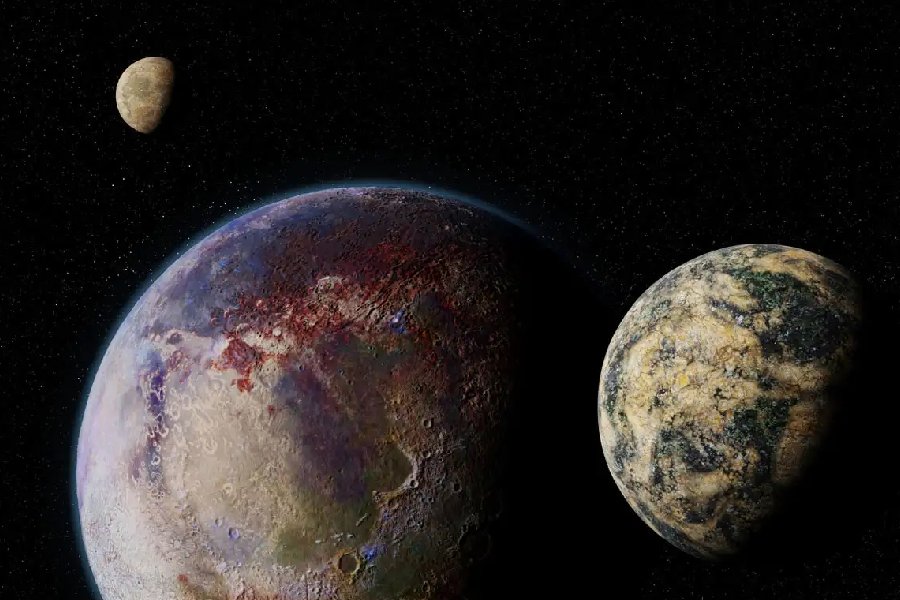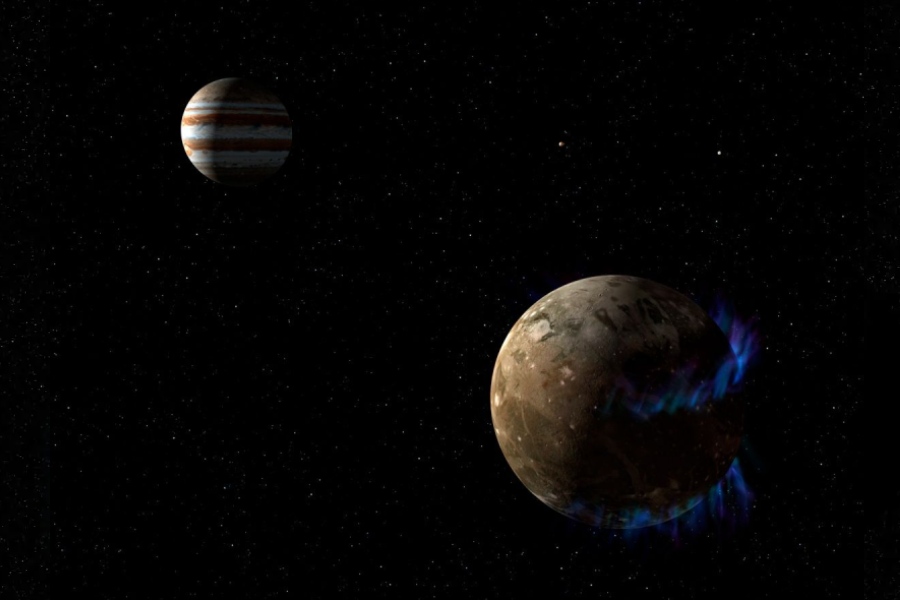As one’s gaze traverses the dark expanse of the night sky, the Moon asserts its presence with its luminous glow. Earth’s solitary natural satellite gracefully orbits, cycling through its familiar phases each month. Yet, one might ponder the many moons scattered in our neighborhood. So, how many moons are in the Milky Way?
Embark on a journey through the intriguing realms beyond our familiar lunar companion. This article offers a guided tour of some of the most captivating moons.
Delve into the intricacies of the moons adorning the planets within our Solar System, exploring the pivotal discoveries that unveiled their unique characteristics. Discover the innovative techniques employed by astronomers to detect these distant natural satellites and much more.

How Many Moons Are in the Milky Way?
Our Milky Way galaxy contains an estimated 100 to 400 billion stars. However, the number of moons in the Milky Way is challenging to quantify precisely.
Moons are natural satellites of planets. Determining the total number of moons in our galaxy is complicated due to the vastness and diversity of planetary systems.
As of now, astronomers have identified over 5,000 exoplanets (planets outside our Solar System), and some of these likely host moons. Still, the exact count remains uncertain and is a subject of ongoing research.
Estimating the multitudes
The Milky Way is home to billions of stars, each playing host to its solar systems, complete with planets and moons. Yet, determining the exact number of moons within this vast expanse proves to be a complex endeavor. Detecting these distant moons presents a formidable challenge, with many likely remaining undiscovered.
Estimates propose the existence of hundreds of billions of moons scattered throughout our galaxy, yet the total count remains uncertain. As time unfolds, ongoing discoveries promise to refine these estimates.
Regardless of the uncertainty, one undeniable truth emerges – significantly more moons than our current capabilities allow us to characterize. This multitude of moons is a testament to the incredible diversity and abundance of planets throughout the Milky Way.
Characteristics of known moons
Each moon has unique traits based on its planet and Solar System. Jupiter and Saturn, characterized by strong gravity, boast numerous moons. Among these, some feature atmospheres and subsurface oceans.
Detecting exoplanet moons poses a greater challenge. Nevertheless, recent discoveries suggest a wide range in sizes, orbits, and compositions. The study of a few hundred moons merely scratches the surface of the diverse lunar landscape within our galaxy. As techniques continue to advance, more revelations about lunar characteristics are anticipated.
Exact Count of Moons in the Milky Way
Detection difficulties
Determining the exact number of moons is impossible because they are challenging to detect over vast distances. Many moons, especially the small and faint ones, elude observation, including dwarf and asteroid-like moons that can be difficult to spot. Additionally, larger moons face the obstacle of being obscured by planet glare.
The current limitations in detection arise from the sensitivities of existing instruments. However, future telescopes promise to uncover more moons, shedding light on these elusive celestial bodies.
Despite these advancements, the total number of moons across the galaxy remains unknown. This leaves a fascinating aspect of our cosmic surroundings yet to be fully revealed.
Estimates and extrapolations
Without an exact count, estimates are made based on known moons. Jupiter’s 79 moons provide a baseline for gas giant satellites. Although less common, rocky planet moons also exist in our Solar System. Exoplanet moons are just starting to be discovered, and their prevalence is still being characterized.
But does the Milky Way have moons? Current estimates for the number of moons in the Milky Way are around several hundred billion. This extrapolation from known moons carries high uncertainty.

Dwarf Planets and Natural Satellites
Moons of dwarf planets
Several dwarf planets are accompanied by small moons in orbit. For instance, Pluto is known to have five moons, while Eris and Haumea each have one.
On the other hand, Ceres and Makemake currently lack confirmed moons. Their small size and irregular shapes typically characterize the moons of dwarf planets.
These moons might be captured by asteroids or objects from the Kuiper belt. The study of these moons offers valuable insights into the origins and composition of their respective dwarf planet systems.
Moon dynamics and orbits
The moons of dwarf planets exhibit unique orbital characteristics. For instance, Pluto’s largest moon, Charon, is tidally locked. Also, they orbit a common point outside Pluto.
In contrast, smaller irregular moons showcase more eccentric and inclined orbits. These observations hint at chaotic capture processes. Therefore, gaining insight into the mechanisms that form moons is crucial for unraveling the evolution of dwarf planet systems.
Mutual impacts
Dwarf planets exert gravitational influence on their moons, molding their orbits gradually. In turn, moons exert their own impact on the dwarf planet through tidal forces. This mutual interaction provides insights into the interior structure of both the dwarf planet and its moons.
By observing the timings of moon transits, scientists can accurately determine the mass and density of a dwarf planet. Consequently, dwarf planets and their moons form intricate mini-systems, presenting fascinating dynamics that researchers are eager to unravel.
Natural Satellites in the Milky Way
Moons of the Solar System
The Solar System is home to more than 200 known moons. Among these, Jupiter and Saturn stand out for hosting the most large moons.
Uranus, on the other hand, boasts a total of 27 moons, while Neptune has 14. Even Mars has two tiny moons of its own.
Additionally, numerous minor planets also have moons. Delving into the observation of this diverse array of moons offers valuable insights into their origins and the interactions between planets.
Exoplanet moon discoveries
Countless exoplanets have been identified; among them, a steadily increasing quantity has been discovered to possess moons. One of the initial observations involved Kepler-1625b-i, which orbits a Jupiter-sized exoplanet.
As detection capabilities advance, the identification of more exoplanet moons is expected. This progress will contribute to a more comprehensive understanding of their prevalence and characteristics.
Beyond the known moons
The 200+ observed moons represent only a small portion of the countless bodies within our galaxy. However, the diversity of moons in our Solar System hints at the extensive range waiting to be discovered throughout the Milky Way.
These natural satellites play crucial roles in shaping and developing planetary systems. Delving into their origins, compositions, and orbits is an ongoing pursuit. Thanks to advancing technologies, we are continuously uncovering more of the galaxy’s moons and deepening our comprehension of their cosmic significance.

Largest Moon in the Milky Way
Jupiter’s Goliath satellite
Orbiting Jupiter, the largest known moon in the Milky Way, is Ganymede. With a diameter of 3,270 miles (5,268 km), Ganymede surpasses both Mercury and Pluto in size.
Ranking as the 9th largest object in the Solar System, Ganymede is one of Jupiter’s 79 known moons. Discovered by Galileo Galilei in 1610, it holds a significant place in the celestial realm.
Icy giant
Ganymede, an icy and rocky world, features a dense iron core enveloped by an icy mantle. The surface displays evidence of tectonic and potential cryovolcanic activity, creating intricate grooved terrain. Beneath the icy exterior, a salty ocean hides.
Despite its frozen facade, Ganymede boasts a thin oxygen atmosphere. Notably, captivating aurora displays have been observed, adding to the allure of this distant celestial body.
Conclusion
Our home galaxy contains multitudes of natural satellites, from tiny asteroids to the mammoth Ganymede. But how many moons are in the Milky Way? Though an exact count remains elusive, estimating the hundreds of billions of moons hints at their prevalence.
Advanced technologies will continue to reveal these cosmic gems across stellar nurseries in our galaxy. As our knowledge expands, so does our appreciation for how natural satellites contribute to the Milky Way’s structure.
This article has illuminated that even more moons exist amidst the billions of stars, each with its own story. Even partial counts convey the immensity of moons in our stellar neighborhood.
